How To Make A Monster
Various ingenious ways movie and TV Doctor Frankensteins have brought their monsters to life…
From the SFX Archives: This is an update of a feature that appeared in 2010
1 Computer Graphics

Director James Cameron gave us cinema’s first true CG monster in the form of the shapeshifting T1000 in Terminator 2 (1991) having experimented with digitally-created lifeforms with the alien water tentacle in The Abyss (1989). The next major breakthrough came with Jurassic Park (1993 – pictured), a film that was going to use Go Motion (see below) to create its dinosaurs until the tech-heads at Industrial Light & Magic showed Spielberg what they could do with their pixels.
Soon it seemed that directors had forgotten there was any other way to create monsters. Fine if you have a decent budget and can create things like the creature from Cloverfield (2008), the title stars of Transformers (2007) or Davey Jones in Pirates Of The Caribbean: Dead Man’s Chest (2006) – poster boys all for the real cinematic magic you can create with pixels.
But it can be a bit of a problem when the cash flow’s not up to the task and you have to settle for the Hanna-Barbera end of the CG spectrum – the devil in Spawn (1997), the shark in Deep Blue Sea (1999), the whatever-they-weres in The Sound Of Thunder (2005). There’s also the danger of a director using CG just because they can, even though they really shouldn’t have bothered – Blawp in Lost In Space (1998) is a particularly heinous offender since the Jim Henson Workshop had already built an animatronic Blawp that had been used during filming. Another pitfall is CG porn, when a director just can’t stop adding CG set pieces even though the poor FX department really can’t keep up and the quality threshold plummets – we’re thinking the CG Jabba The Hutt in the Special Edition of The New Hope (1997) or the dino stampede in Peter Jackson’s King Kong (2005). And some directors should be banned from using CG ever again – yes, Stephen Sommers we mean you after that CG werewolf and CG Mr Hyde in Van Helsing .
On the other hand, Mr del Toro, you can create CG beasties whenever you like.
2 Stop Motion
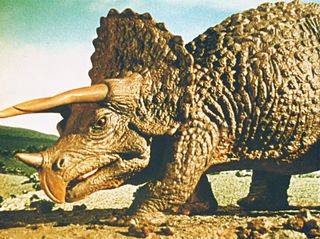
The 3D version of cartoons, this is a form of animation where you take a model and film it one frame at a time, moving it slightly between each shot. Its cinematic pioneer was Willis O’Brien who made audiences faint with his realistic dinosaurs in The Lost World (1925) before using the technique to create the groundbreaking King Kong (1933). Watching that film when it first came out was Ray Harryhausen, who was so overawed he decided he too wanted to spend the rest of his working life locked away in a shed. Lucky for us he did, because he gave us some of cinema’s most memorable monsters, including the fighting skeletons and bronze giant Telos in Jason And The Argonauts (1963) and Medusa in Clash Of The Titans (1981).
3 Go Motion
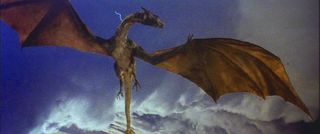
In 1982 it seemed as if Go Motion was the future of special FX, but then someone went and invented CGI (which, believe it or not, was cheaper even then). Go Motion was a kind of computer-controlled, advanced version of stop motion in which the models were filmed a few frames at a time; this eliminated the jerkiness of stop motion. It was developed for Dragonslayer (1981- pictured) and used extensively in The Empire Strikes Back (1980) for the AT-ATs.
Sign up to the SFX Newsletter
Get sneak previews, exclusive competitions and details of special events each month!
4 Men In Rubber Suits

From the sublime ( The Creature From The Black Lagoon - 1954) to the ridiculous ( Doctor Who ’s slug-like Gastropods - 1984), the simple solution of putting a man in a suit (usually rubber) must be the most common way to create your onscreen monster. You can spend millions hiring the world’s top designers and FX technicians to create the costume, like Ridley Scott did in Alien (1979), or you can stick some schmuck in a gorilla costume and a deep sea diving helmet like they did with Robot Monster (1953). It does help if your monster is basically humanoid in shape, but the Japanese never worried about such things in the Godzilla movies.
There are other ways of disguising the fact that your monster is, in fact, a man in a suit but we’ll get to those in a moment…
5 Men In Metal* Suits
(*Or more usually plastic, cardboard or lycra sprayed silver in an attempt to look metal)
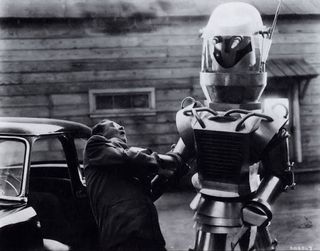
For the poor jobbing thespian, the only role worse than a rubber-suit alien is a metal suit monster. All the same downsides, with added weight and more chance of a sharp edge digging in to the flesh above your knee. The reason why various producers decided to use metal-paint-sprayed alternatives probably had less to do with kindness to actors and more to do with cost. Amazingly the Full Metal Jacket approach, despite being cumbersome and unwieldy, has produced some of the screen most impressive and memorable ’bots, specifically Robby The Robot and Doctor Who ’s K1. Even the Full Fake-Metal approach gave us Gort from the original The Day The Earth Stood Still .
6 Men On Castors
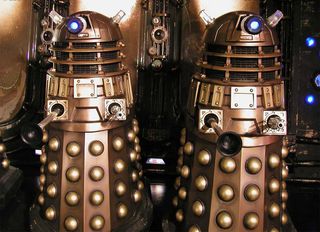
An alternative to the man in the suit is to put your man in a casing of some sort. This is usually used for metallic menaces, the sort that glide rather than walk. Doctor Who has turned this into something of a specialty with the Daleks, the Mechanoids, the Cleaners and the L1 robot to name but a few. The TV series Lost In Space also used this method for its Robot.
7 Prosthetics
.
8 Puppets
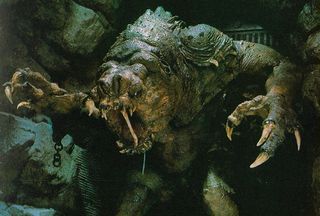
There’s more to puppet monsters than the Jim Henson Workshop, though as their own movies – such as The Dark Crystal (1982) and Labyrinth (1986) – showed that they are the masters of the art. The Land That Time Forgot (1975) had an entire bestiary of hand-puppet dinosaurs, and the Rancor in Return Of The Jedi (1983) had an operator’s hand up its jacksie. Even some of the alien effects in Alien3 (1992) were achieved with a miniature rod puppet. And who could forget the Bandrils in Doctor Who ? Oh, you have…?
9 Larger Than Life

Some monsters are real. No really. Thanks to a bit of photo trickery any common or garden varmint can be a giant monster. Lizards are especially popular – this technique has been nicknamed "slurposaurs”. The first film that used reptiles dressed as dinosaurs was DW Griffith's Brute Force (1914). While the rest of the monsters in One Million Years BC (1966) were animated by Ray Harryhausen, the first one we meet is an optically-enlarged lizard which does little other than blink (the studio lights made it sleepy, according to Harryhausen). Famously thrifty producer Irwin Allen also used real lizards with stuck-on plastic fins in The Lost Budget … sorry, The Lost World (1960). Giant rats featured in the similarly cash-strapped Food Of The Gods (1976) a film that purports to be adapted from an HG Wells book, but seems to have been written by someone who only read the words “giant rats” before scurrying off to type the script. The Beginning Of The End (1957) manages to cheapest trick of all, with a load of ants crawling over a photograph at one point.
10 Adapt An Animal
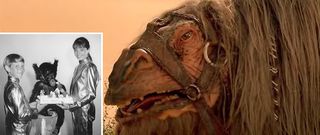
Why put a man in a suit when you can put an animal in a suit? The Mastages in Stargate (1994) were cosplaying horses while the Banthas in Star Wars Episode IV: A New Hope were elephants in rugs and fright masks. The ’60s TV series of Lost In Space , meanwhile, tried to fool us that a monkey in a tea cosy with fluffy Vulcan ears was, in fact, a Bloop.
11 Animatronics

Animatronic guys will build you a full-scale monster with robotic moving parts. The masters of the art are the Jim Henson Workshop and Stan Winston Studios. In fact, Henson’s created the TV show Farscape partly as a showcase for their work and the series does indeed boast some of the finest, most imaginative monsters ever created for the small screen.
The job has been complicated with the introduction of CG by the fact that directors often want animatronic monsters that match the look of CG monsters in the same movie. All credit to the guys at Winston’s – you have to look carefully at the T-Rex sequences in Jurassic Park (1993) to work out what’s real and what’s computer generated.
12 2D Animation

The producers of Forbidden Planet (1956) hired an animator from Disney, Joshua Meador (who'd worked on Fantasia ) to create the sequences when the usually-invisible Monster From The Id is caught in an energy beam and its true form is revealed. Nice idea, but he does move a little bit too much like a ’50s Disney character…
13 Using Disabled Actors
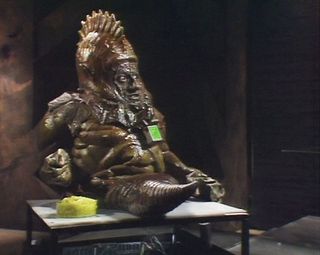
Controversy-courting director Michael Winner caused a stir in 1977 with The Sentinel , when he hired disabled and deformed “actors” to portray the denizens of Hell. He was accused of reducing them to freakshow attractions. Doctor Who used the diminutive, disabled actor Nabil Shaban to portray evil tadpole Sil in 1986 (pictured), but as attention wasn’t drawn to his disability no similar controversy followed. It’s a fine line – and Shaban was wary at first – but in the end, being inside the costume meant that everyone was paying more attention to his performance rather than his disability. The three droids in Silent Running (1972) were played by amputees with no legs, who walked on their hands.
14 Condoms

We’re not sure if there are too many examples of prophylactic-based monsters, but we can confirm that the makers of the infamous 1973 Doctor Who story “The Green Death” – the one about giant green maggots – did use condoms to create some of the “background” maggots to pump up the crowd scenes. .
15 Two For One
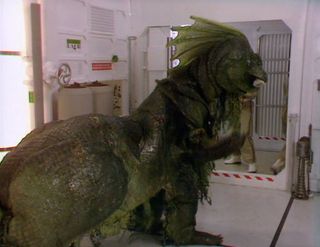
Another case of trying to disguise the “man-in-suit” technique featured in Doctor Who ’s “Warriors Of The Deep” (1984) when they the guys who played pantomime horse Dobbin in Rentaghost to perform similar duties for the four-legged Myrka. The result was not very successful; it simply looked like two men in a green panto cow suit, and it left paint all over the set.
16 Man Walking Backwards
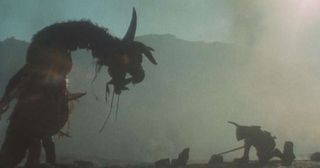
Yet another variation on trying to disguise the man-in-a -suit approach: get the actor in the suit to walk backwards ( Jabberwocky , 1977).
17 Man Bent Over Backwards
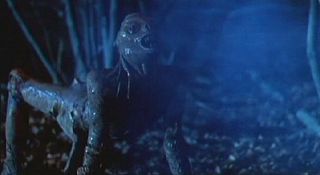
An even more desperate human-form-disguising man-in-suit technique was used in cheap horror flick Xtro (1983). At one point the poor thesp in the suit had to walk on all fours, but bent over backwards with his back towards the ground! The effect is rubbish. Like the rest of the film. .
18 You Need Hands

The monster at the climax of the TV version of The Quatermass Experiment (1953) was played by the show’s writer, Nigel Kneale… or, to be more exact, his hands. He wore gloves covered with vegetation and leather then stuck his mitts through a blown-up photograph of Westminster Abbey. You may laugh at the primitiveness of the effect, but 26 years later Ridley Scott used his hands and some backlighting to create the effect of the embryonic creature moving about inside its egg in Alien (1979). When Doctor Who had to create a giant vampire for “State Of Decay” (1980), there was only enough of a budget to pay for one hand (above) thrusting through a model set.
19 A Carpet
One of the cheapest monsters ever appeared in The Creeping Terror (1964), which looks like a carpet thrown on top of a bunch of people crawling along on their hands and knees. That’s because it was a carpet thrown on top of a bunch of people crawling along on their hands and knees. In fact, you can see hands and feet sticking out in some shots.
20 A Balloon
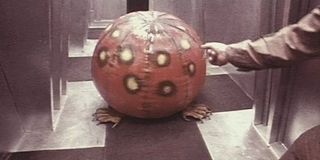
Director John Carpenter’s 1974 student-film-that-made-good, Dark Star (he was given money by a distributor to shoot extra footage to make it releasable) features a vicious alien that is nothing more than a large balloon with stuck-on feet.
21 Tie A Mask Onto A Dog
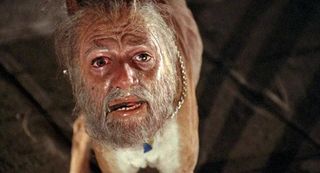
Sticking a mask on a mutt is a method that didn’t work so well in The Killer Shrews (1959) but is surprisingly effective in one brief, but memorable scene in the remake of Invasion Of The Body Snatchers (1978 - pictured).
22 Plagiarism
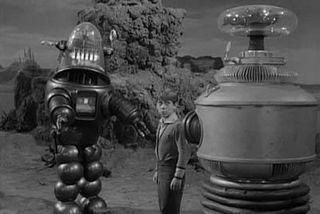
Cheapskate Irwin Allen – the producer behind disaster movies like The Towering Inferno (1974), as well as TV series such as Voyage To The Bottom Of The Sea and Land Of The Giants – was not just the king of stock footage, but the king of the stock cupboard as well, reusing existing sets and props with gay abandon. In the Lost In Space episode “War Of The Robots” the metal menace was, in fact, just Robbie The Robot from Forbidden Planet , reprogrammed to be a bit of a bastard. Alen also liked plundering his own film version of The Lost World (1960) for stock footage of monsters he could use in his TV shows.
23 Don’t Bother
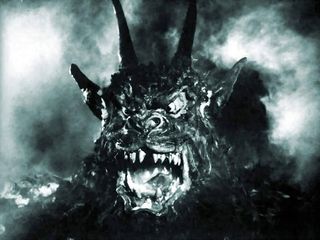
Many horror directors will tell you that real horror is created by the unseen. This approach certainly helped Torchwood ’s “Children Of Earth” where the aliens were mainly hidden inside a thick foggy gloop. You got to see some snot and tentacle here and there, but you can’t help thinking that on a BBC budget, it was probably a clever move never to reveal the actual creature in full – it was bound to be a disappointment.
This was also the original intention with 1957’s Night Of The Demon , a damned fine film, full of psychological horror and atmospheric build up. Unfortunately, the distributors demanded that the demon put in an appearance at the climax. Bad move. To be fair, the monster (above) ain’t that bad; it simply doesn’t live up to the terror that’s been forming in your mind.
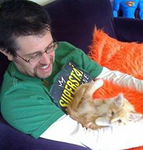
Dave is a TV and film journalist who specializes in the science fiction and fantasy genres. He's written books about film posters and post-apocalypses, alongside writing for SFX Magazine for many years.
Most Popular

